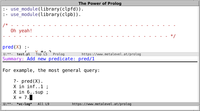Engineering Aspects
Prolog Development Environment
There are several good development environments with
special support for Prolog coding.
For example, see PceProlog to
configure GNU Emacs for Prolog.
The comp.lang.prolog FAQ
contain pointers to several additional environments.
Prolog systems ship with different features that
make compiling and consulting your code easier. For
example, in SWI-Prolog, you can invoke the built-in
predicate make/0 to reconsult all source files. This
feature works to various degrees, depending on other features you
are using. Using ediprolog, you can stay
in the Emacs buffer, and interact with Prolog directly in the
buffer.
I recommend you use the system that works best for you, i.e., I
recommend you use Emacs for Prolog development. Make sure to
configure your keyboard so that you can
use Caps Lock as an
additional Ctrl key! In my experience, Emacs is most
usable with a Dvorak keyboard layout.
| Video: |

|
Module Systems
For programming in the large, and even for
programming in the medium, and even for several
other kinds of programming, you will want to make use of your
Prolog's module system to separate logical units
of code.
Different Prolog implementations support different kinds of
module systems. Notably, there are functor-based module
systems and predicate-based module systems, with different
consequences and trade-offs. It is very hard to design a
module system and think all consequences through. Usually,
conflicting requirements are imposed on a module system: On the
one hand, you want to use modules
to separate concerns, and on the other hand, you want
to support code introspection and other features that
run counter to true separation. Therefore, typical module systems
are ultimately inconsistent, yet useful for structuring your
source files and avoiding name conflicts.
Using a particular module system is usually very
straight-forward. Essentially, you typically place
a module/2 (or similar) directive in your source file,
such as:
:- module(my_nice_module, [first_exported_predicate/2,
second_exported_predicate/1,
third_exported_predicate/4,
...
]).
where the various exported predicates are listed by their
predicate indicators (name and arity). In Prolog files
that use a module, you place a
corresponding use_module/1 (or similar) directive, such
as:
:- use_module(my_nice_module).
A major advantage is that the internal predicates
of my_nice_module cannot cause conflicts with internal
predicates of other programs and modules.
Timing and Profiling
Different Prolog systems provide different ways to time
and profile your predicates. For example, in
Scryer Prolog, you can use the predicate time/1
from library(time)
to measure the run time of any goal. For example:
?- time((X in 0..1_000,indomain(X),false)).
% CPU time: 0.389s
false.
SWI-Prolog ships with a very nice profiler which you can
invoke via profile/1. Simply supply the goal you want to
profile as an argument. Other systems such as SICStus Prolog
also ship with a
built-in profiler.
Most Prolog systems provide the predicate statistics/2
which you can use to take your own measurements. For example, we
can define the relation between a goal and the
CPU time it takes until it succeeds:
goal_time(Goal, T) :-
statistics(runtime, [T0|_]),
Goal,
statistics(runtime, [T1|_]),
T #= T1 - T0.
We can now obtain the CPU time (in milliseconds) of any
goal Goal via the query:
?- goal_time(Goal, Time).
I highly recommend such tools to measure the performance of your predicates.
Exceptions and Errors
Prolog supports raising and handling exceptions. As the
name implies, this mechanism is useful to
handle exceptional situations. Some of these situations are
already prescribed in the ISO standard. The most important
ones are:
- type error: This exception is raised when a
particular type of term is expected, but a different
kind of term is present. The ISO standard explicitly
defines sets of terms (such as integer, list
etc.) for which a type error may be raised.
- domain error: This is very similar to a type
error: A different kind of term than is present is
expected. The difference to a type error is that the kind of
term that is expected is not among the predefined types
that are defined in the standard.
- instantiation error: This exception is raised
when a predicate argument is
insufficiently instantiated, i.e., a variable
occurs where a more specific term is expected.
There is a very important semantic difference between these
exceptions: Declaratively, a type or domain error
can be replaced by silent failure, because no further
constraint you add to the (monotonic) program can turn such a
situation into success. On the other hand,
an instantiation error must not be
replaced by silent failure, because there could still be
solutions in such cases, and adding further constraints may
reveal them.
Here are two examples that illustrate these cases:
?- X #= a.
ERROR: Domain error: `clpfd_expression' expected, found `a'
?- X in Y.
ERROR: Arguments are not sufficiently instantiated
It is easy to see that adding further constraints can make
the second query succeed:
?- Y = 0..5, X in Y.
Y = 0..5,
X in 0..5.
However, no additional goal can ever
make X #= a succeed, and therefore
this domain error could also be replaced by failure.
In exceptional situations, exceptions are typically more useful
than silent failure, because they let you reason about
the cause of the problem.
You can use the standard predicate throw/1
to raise an exception, and the standard
predicate catch/3 to handle exceptions.
Unit Tests
Unit tests are an extremely important tool to detect
regressions in your code.
Prolog is eminently well-suited to formulate and run unit tests.
Using declarative descriptions and Prolog's built-in backtracking
mechanism, you can quickly formulate tests that cover a vast range
of possible tests. Essentially, state what ought to hold,
and then simply run these queries to test whether
it does hold.
There is a unit testing framework
called PlUnit
that is available for SWI-Prolog and for SICStus Prolog.
More about Prolog
Main page

